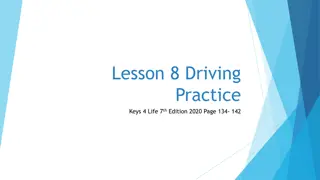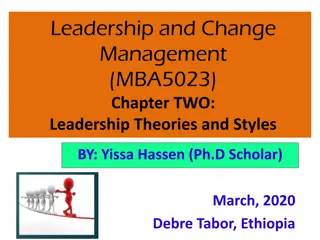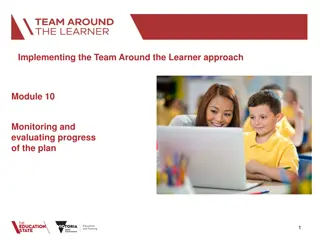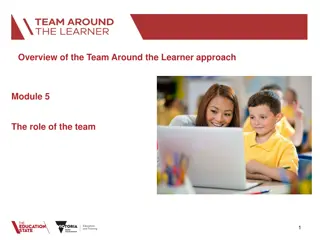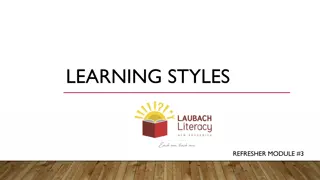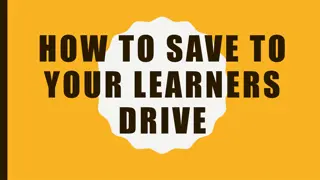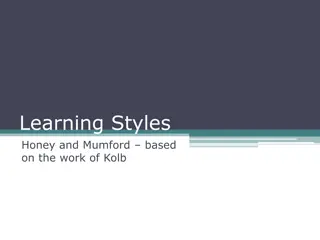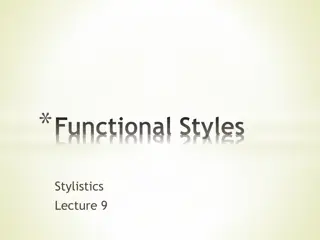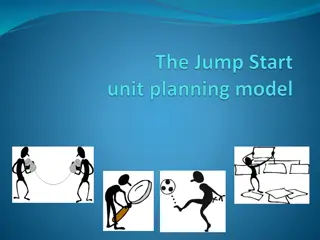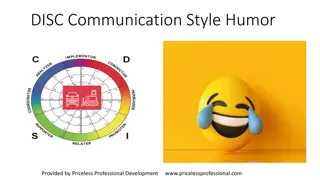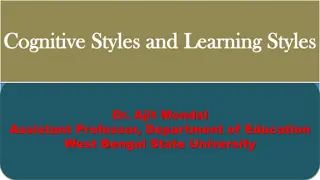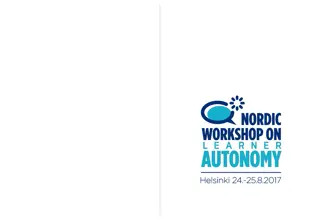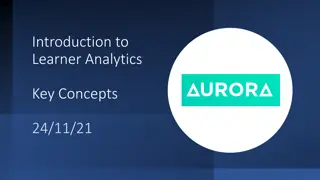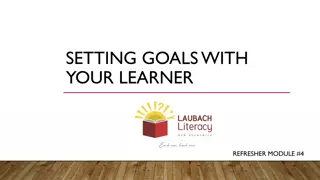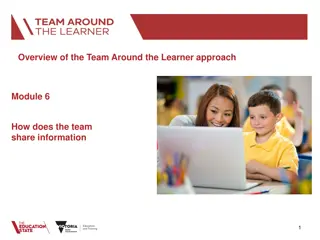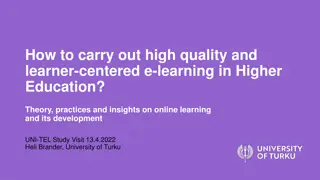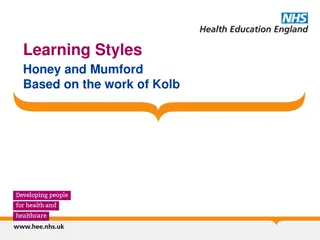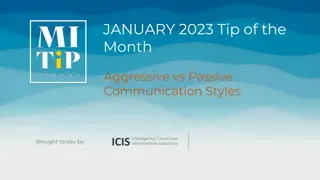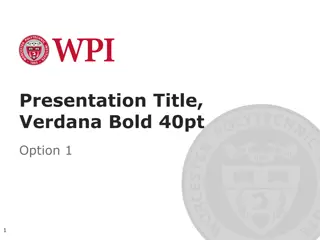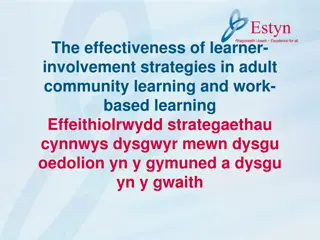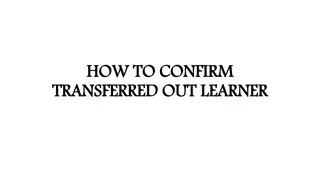Understanding Learner Styles and Strategies
Learner styles and strategies play a crucial role in education. There are two main types of learners - Analytic Learners who focus on details first, and Holistic Learners who prefer understanding the whole concept. Analytical learners excel at recalling facts, excel in math and science, and are good at time management. Learning strategies can vary within an individual, and styles can change across individuals. Different learner styles include Conformists, Convergers, Communicative Learners, and Concrete Learners. Individual variations in learning include Neuro-linguistic programming (NLP) techniques such as Visual, Auditory, Kinesthetic, Olfactory, and Gustatory preferences.
Download Presentation

Please find below an Image/Link to download the presentation.
The content on the website is provided AS IS for your information and personal use only. It may not be sold, licensed, or shared on other websites without obtaining consent from the author. Download presentation by click this link. If you encounter any issues during the download, it is possible that the publisher has removed the file from their server.
E N D
Presentation Transcript
LEARNER STYLES and STRATEGIES
LEARNER DIFFERENCES PERSONALITY AGE APTITUDE LEVEL LEARNING STYLE MOTIVATION
LEARNERS are basically of TWO types : ANALYTIC LEARNERS & HOLISTIC LEARNERS
ANALYTIC LEARNERS They prefer to focus on learning the small details first and then move on to make sense of the whole concept. HOLISTIC LEARNERS, on the other hand, are interested in the whole concept rather than the small bits.
Analytical learners tend to have good memories, so they excel at recalling facts, formulas, and names. They tend to be good at time management and are great at planning ahead and staying well organized. Since they learn manner, traditional school settings are a good fit for them and they are often able to learn from traditional teaching methods without a lot of intervention needed. in a sequential
These learners are often able to remember oral independently take notes, and make sense of lecture style lessons at school. They are naturally reflective and can evaluate themselves and learn from their mistakes. Analytical learners tend to excel in math, science, and engineering courses since they can make sense of steps and formulas. directions,
PERSONALITY LEARNING STYLE LEARNING STRATEGIES TECHNIQUES / TACTICS
Learning individuals. However, learning strategies change within an individual. styles change across
LEARNER STYLES Conformists Convergers Communicative Learners Concrete Learners
INDIVIDUAL VARIATION Neuro-linguistic programming [ NLP ] Visual Auditory Kinesthetic Olfactory Gustatory
MULTIPLE INTELLIGENCE [ MI theory ] *Linguistic Learner *Logical / Mathematical Learner * Spatial Learner *Musical Learner *Bodily / Kinesthetic Learner *Interpersonal Learner *Intrapersonal Learner
Linguistic [ Verbal ] Learner * likes to read, write and tell stories * is good at memorizing names, dates, .. * learns best by saying, hearing and seeing the words Spatial [ Visual ] Learner * likes drawing, building and designing, daydreaming * is good at imagining things , reading maps, charts * learns best by visualizing, dreaming, using one s eye, working with pictures & colours
Logical [ Mathematical ] Learner * likes doing experiments, figuring things out, working things out, work with numbers, ask questions, ... * is good at math, reasoning, logic and problem solving * learns best classifying, working patterns/relationships by categorizing, with abstract
Auditory [ Musical ] Learner * likes singing, humming tuneslistening to music, playing an instruments,, ... * is good at picking up sounds, remembering melodies, noticing pitches/ rhythms, keeping time, ... * learns best by rhythm, melody, music.
Kineasthetic [ bodily ] Learner * likes moving around, touching and talking, using body language * is good at physical activities [ sport, dancing, acting, ..] * learns best by touching, moving, intearcting with knowledge through bodily sensations space, processing
Interpersonal Learner / The Socializer * likes having lots of friends, talking with people, joining groups * is good at understanding people, leading others, communicating, manipulating, ... * learns best by sharing, comparing, cooperating, interviewing, ... organizing,
Intrapersonal Learner * likes working alone, pursuing own interests * is good at understanding self, focusing inward on feelings/ derams, following instincts, being original, .. * learns best by working alone, individualized projects, instruction, having own space, ... self-paced
OTHER LEARNING/LEARNER STYLES * Tolerant of ambiguity * Reflective vs Impulsive * Field Independent vs Field Dependent * Left- and Right- Dominance
Tolerant of ambiguity * Tolerance of ambiguity simply refers to being willing to tolerate ideas. * Some people are open-minded in accepting ideologies, events and facts that contradict their own views; they are ambiguity tolerant * People who are intolerant are more- closed minded, dogmatic, and tend to reject items that are contradictory.
Language learners are always facing new linguistic items, many of which are ambiguous. Successful learning requires tolerance of such ambiguities. On the other hand, too much tolerance has a hampering effect. language
Field Independence / Dependence [ FID] A field independent [ FI] style enables you to distinguish parts from a whole. [ E.g. The ability to find the hidden objects in a picture ] In field dependence [FD] , on the contrary, the person is so dependent on the field that parts embedded are not easily perceived.
Too much field independence may result in cognitive tunnelvision . That is, you see only the parts and not their relationship to the whole. FI persons tend to be generally more independent, competitive, and self- confident. FD persons socialized, to derive their self-identity from persons around them and usually more emphatic. are more
A FI style is associated with classroom learning that involves analysis, attention to details, mastering of exercises. On the other hand, a FD style is associated with communicative aspects of language, natural learning.
Reflective Learnes Impulsive Learners * cautious *avoid to make a quick guess to a problem * make more calculated decisions * rigid * fewer errors * intraverted * anxious * less tolearnt * risk takers * make a quick guess * more tolerant * relaxed * extraverted * flexible * faster readers
Sharpener vs Leveler [ related to the learner s flexibility to changes] Sharpeners can easily adjust to changes while leveler resist changes.
STRATEGIES IN SECOND LANGUAGE LEARNING and ACQUISITION PROCESS LEARNING STRATEGIES Metacognitive Strategies Cognitive Strategies Socio-affective Strategies COMMUNICATION STRATEGIES
Meta-cognitive strategies Meta-cognitive strategies are strategies that help learners think about their own learning. In a way, they are the strategies that manage learning. They involve; * planning [ planning to carry out an upcoming language task ] * thinking about the learning process * monitoring [ understanding ] * evaluating [ developing the ability to determine how well the task has been accoplished. self-checking one s
Cognitive strategies Cognitive processes used directly in learning which enables learners to deal with the information presented in tasks and materials. For example, memorization, induction, deduction, transfer, grouping are the examples of cognitive strategies. strategies are thought inferencing,
Socio-affective strategies Socio-affective strategies are the strategies which provide learners with opportunities for practice. They involve; * cooperation [ learning how to work with peers ] * clarifying [ learning to ask questions to get additional information from the teacher or somebody else who might know the answer ]
Communication Strategies Communication Strategies are those that are used to make oneself understood in order to maintain a conversation despite the gaps in their knowledge of the second language. For example; gesture, mime, synonyms, paraphrase, cognate words are the ones that usually used as communication strategies.



